Exhibition information
of various artists
2018-10-20(토) ~2018-11-02(금)
김광미 개인전 心
초대일시 : 2018-10-20 05:00 PM
전시작가 : 김광미
■ 추계예술대학교 미술학부 서양화과졸업 (1988)
■ 개인전/Solo Exhibition
2018 [心] (예술표현활동지원선정, 인천문화재단/ 갤러리GO,인천)
풍경 안 숨소리 (갤러리미홀/ 화랑빛여울 초대전, 인천)
2017 김광미 초대전 (밝은세상갤러리, 인천)
쉼으로 [숨:] (광록화랑초대전, 서울)
쉼으로 [숨:] (서담재 신년기획초대전, 인천)
2016 삶-풍경...愛 (선광문화재단 갤러리, 인천)
2015 삶-풍경...愛 (예술표현활동지원선정, 인천문화재단/ 갤러리GO, 인천)
2014 삶-바라보고...바라보기 (뫼비우스-띠갤러리/인천)
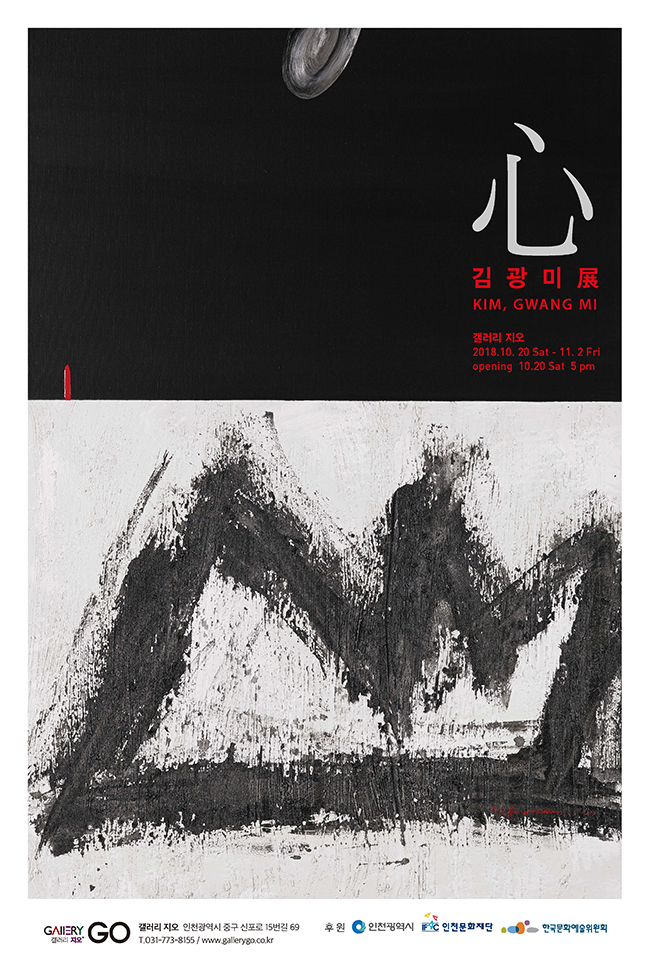
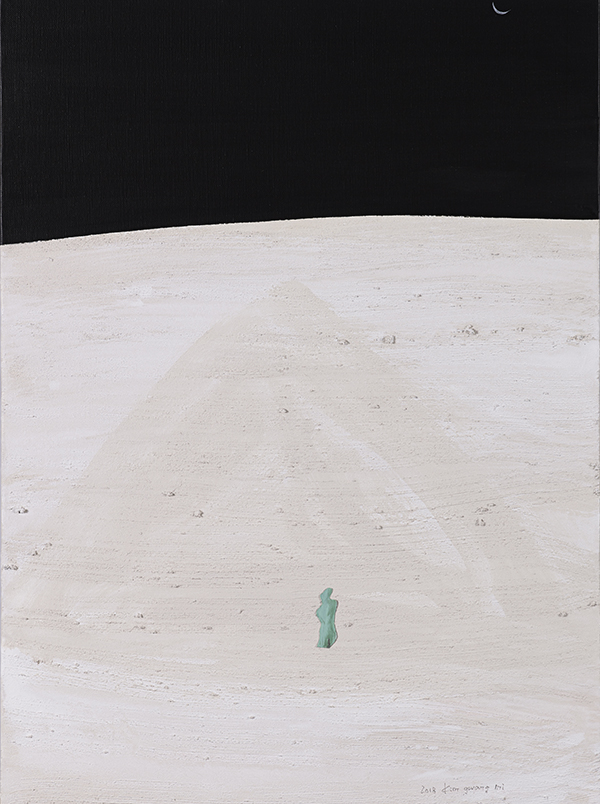
2018心_풍경Mixed media on canvas,lithography72.7-53.0cm (3)
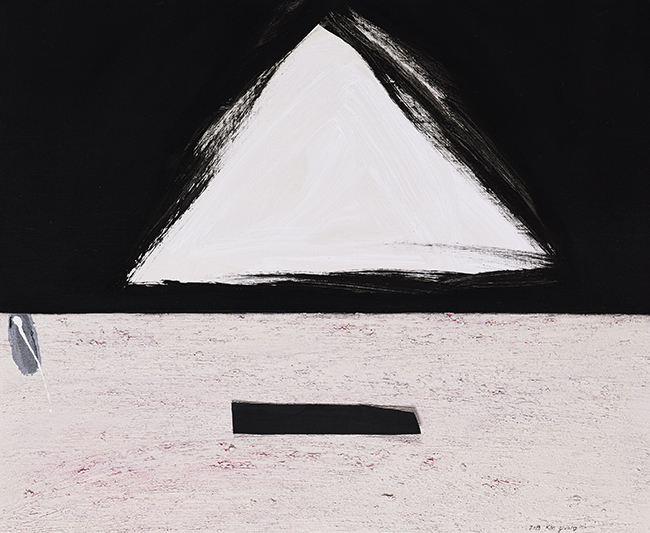
2018心_풍경Mixed media on canvas,lithography72.7-60.6cm (3)
작가 김광미 근작에 대한 소론
실존, ‘관조의 망루’에서 묻다-답하다
홍경한(미술평론가)
1. 작가 김광미 작품은 실존의 문제와 맞닿는다. 실존이란 항상 세계내존재이듯, 작가 역시 영적인 것과 육체적인 것과의 간극, 타자와 부딪히며 살아가는 인간으로서의 존재의식이 작업의 발로라고 할 수 있다. 그렇기에 삶과 풍경, 바라보고 바라보기, 숨과 애(愛), 심(心) 등을 키워드로 한 그의 그림은 단순한 추상을 넘어 특수하고 개별적이며, 존재 의미에 대한 탐구이면서 근본적으론 존재양식에 대한 문제를 다룬다. 그래서 김광미에게 예술이란 ‘현존재’에 관한 예민한 자기투영이다.
김광미의 작품들은 삶에 있어 제한하거나 제약받는 상황에서 싹을 틔우며, 조형은 고의적 드러남과 감춰짐의 틈에서 자란다. 이는 일종의 내재율(內在律)로, 드러남과 감춰짐은 상보적 작용을 거치며 작품 내에 뿌릴 내린다. 마치 억 겹의 나날을 드러내는 것 마냥 서서히 말라 고착된 채 집약된 ‘삶의 궤적’에서 체감했을 법한 어떤 결을 깊이 있게, 함축적으로 보여준다. 여기서 말하는 어떤 결이란, 삶과 죽음 사이에서 체감한 절망이나 현실의 암담함 혹은 그것으로부터 비롯된 깊은 어둠일 수 있다. 어쩌면 영적인 것과 육체적인 것과의 간극, 세상과 부딪히며 살아가는 우리 인간이 느낄법한 모든 순간자체일 수도 있다. 그러나 그건 어디까지나 문자화 혹은 조형화되지 못하는 것이기도 하다.
‘삶의 궤적’은 두 가지 등선에 위치한다. 첫 번째는 조형의 빌미다. 작가가 오랜 시간 화두로 삼은 관조하기, 바라보고 바라보기는 곧 ‘서사화하기’라고 할 수 있다. 이것은 궤적 위에 놓이는 구체적 언어요, 표상화 되는 순간 생성되는 ‘궤적의 풍경’이라 해도 무리는 없다. 하지만 애(愛)와 심(心)이 암시하듯 아이러니하게도 이는 가시적 범주에 있지 않다. 시각적 발견은 불가능하며, 읽기도 어렵다. 무언가를 꾹꾹 눌러왔듯 기호적이고 상징적이며 에두르는 탓이다. 그러므로 눈에 보이는 이미지는 어디까지나 하나의 장막일 뿐이다.
다만 우린 그의 그림(표상체계)을 통해 감정이입을 하고, 물성과 반비례한 관념의 노획을 통해 찰나의 연속인 존재에 관한 자문을 헤아릴 수 있다. 역대 추상표현주의 그림에서 알 수 있듯 공명이란 반드시 재현의 영역에서만 이뤄지는 것은 아니기 때문이다. 하지만 김광미 특유의 내재율이 지닌 특성은 알 수 없는 마음의 동요를 전달하기에 부족함이 없다.
‘삶의 궤적’ 그 두 번째는 삶과 직접적으로 연관되는 자아의 투사이다. 김광미의 작품은 ‘심리의 그늘’ 밑에서 피어난 감정, 의지와 같은 여러 심리적-정신작용의 주관임을 암시한다. 그곳엔 환상이 없다. 자신을 옥죄는 세상이라는 그물도 없다. 대신 현실계에서의 결핍과 충족의 조형적 인용이 들어 있으며, 내적 혼란과 존재의 불안으로부터 벗어나려는 구원의 갈망, 자유로의 의미가 배어 있다. 그리고 이 모든 것은 자의식을 소실점으로 하며, 그 소실점을 축으로 굴레로부터의 자유, 소통, 욕망, 절제, 관조, 성찰 등의 명사가 놓인다.
마티에르 두터운-거칠고 투박한 옛 작품들도 그렇지만, 김광미의 근작 또한 어쩌면 불완전할 수밖에 없는 존재에 근접한다. 삶을 지탱해온 무언가의 한 귀퉁이에 의지한 채 본능적으로나마 느끼는 유토피아를 향해 놓여 있다가 처절하게 말라 타들어가는 초라한 존재의 불안감이 배회하는 것도 그런 이유다.
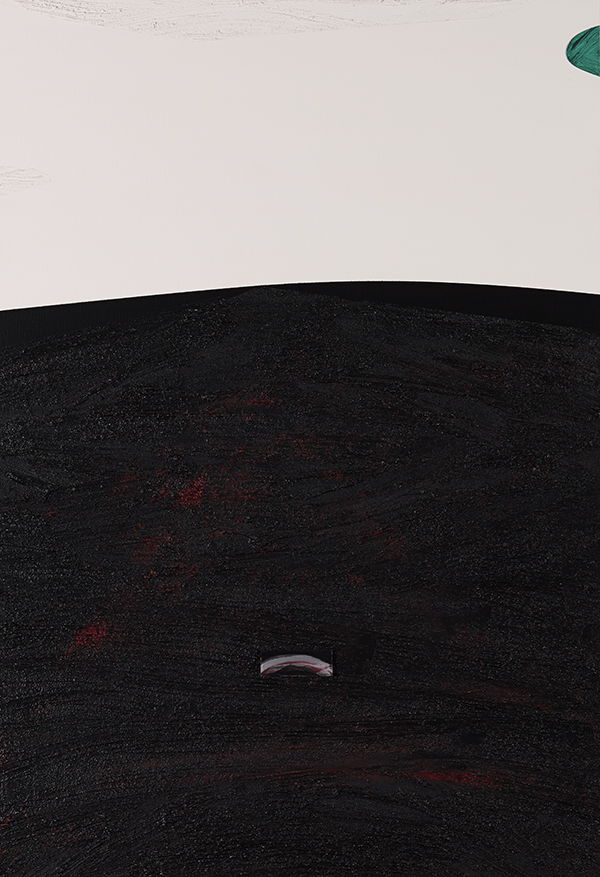
2018心_풍경Mixed media on canvas,lithography80.3-116.8cm (2)

2018心_풍경Mixed media on canvas,lithography80.3-116.8cm
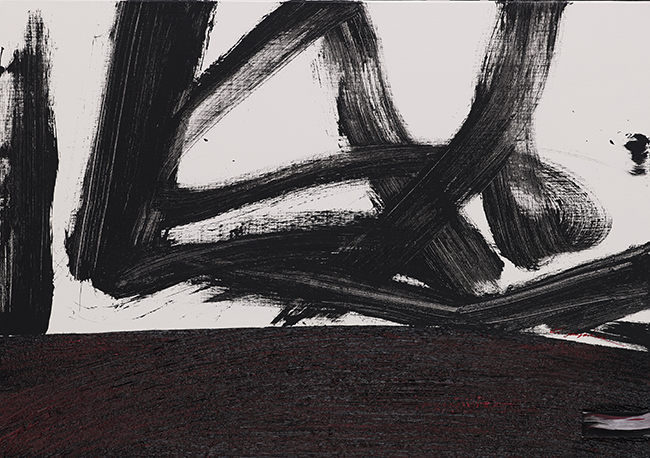
2018心_풍경Mixed media on canvas,lithography90.9-65.1cm (2)
2. 김광미의 그림은 화장기 없는 맨 얼굴로 마주할 수 있는 진실한 무대이자 세상에 대한 반응임을 고지한다. 작가에게 세상이란 몸과 정신으로 느끼고 체감한 것들의 반영임을 일러준다. 특히 그의 근작들은 살며 살아가며 느끼는 기쁨과 슬픔, 좌절과 고통, 비애와 환희 등을 미적 거름망을 통해 걸러낸 결과물이다. 걸러낸 자리, 즉 내면과 외계 간 마찰과 충돌로 거친 듯 조용하게 여울진 장소에 들어선 건 내면을 향한 희구(希求)이다. 원하는 것, 바라는 것, 보이는 것, 볼 수 있는 것을 포함한 모든 풍경이다.
흥미롭게도 김광미의 모든 작업은 구성되어질 수 있는 어떤 것을 빗대더라도 구체적 사물로부터 시작된 재현이 아니다. 그렇기에 그의 작업은 감각적, 직관적 흐름이 다분하고, 형태는 모방에 충실하지 않다. 하지만 그것이 오히려 관자들의 가치관 혹은 관점에 따라 여러 가지 격정적 시상(詩想)을 제공하며 김광미의 작품은 그 관점에 너그럽다.
일례로 흑과 백으로 분리된 채, 삼각형, 사각형의 기하학적 구성을 하고 있는 그의 여러 근작들은 표면적으로 앞서 기술한 삶의 풍경과 직접적이지 않다. 그보단 면과 선, 색과 사물이라는 조형요소를 통한 유보의 관념과 가감의 보류라는 개념이 앞선다. 여기서 가감은 곧 비움과 채움의 활성화(또는 정체화)를 나타내나 ‘비움’보다는 ‘채움’의 여백주의를 실천하는 방식으로 고유한 미감을 획득하고 있다는 게 중요하다.
다소 물질성이 두드러지는 일부 오브제 작업도 매한가지다. 금속판에 타원형의 묘한 이미지를 새긴 이 오브제 작가는 이 오브제에 대해 다음과 같이 말한다. “사회적동물일 수밖에 없는 인간의 존재감과 원초적인 나의 존재감 사이에서 부딪히는 이성과 감성 사이의 내밀한 생각들을 표출하기에 지금의 이 오브제들은 현재 진행형으로 내겐 중요한 부분 중 하나로 선택 되어지는 것이다.” 작가는 그동안 흙이나 짚, 인쇄용 마판(석판화용 재료)을 문명의 부산물의 상징으로 사용해 왔다.
는 어둡고 건조한 공간에서 독자성을 띤다. 재료가 금속이기에 평면의 회화와는 달리 물질성은 한층 강조된다. 그러나 그러함으로써 조형적 대비는 두드러지고, 개인적 함의에 집중되는 역할을 한다. 이 오브제는 여성인 작가 자신의 히스토리를 포괄하며, 평면과 입체로 조응시키면서 (의외의, 불현 듯, 예상 가능한)반응의 공간을 형성한다.
이 가운데 그의 그림에 자주 등장하는 산(山) 모양의 도형과 삼각형, 여타 작품에서 곧잘 표현되는 인체와 자연물 등은 주체에 관한 은유적 서술이다. 특히 근작에서 강조되곤 하는 화면 분할은 비가시적인 이미지를 통해 숨겨진 공간을 보다 확장하면서도 동시에 기존의 열린 공간을 구획 짓는다는 점에서 양가적 속성을 지닌다.
양가적 속성은 말 그대로 작가 개인과 공동체의 단락을 의미하는 것이자 속박의 오늘이고, 조응을 뒤로한 관조이자 예민한 관찰이다. 관조와 관찰의 조형인 넓은 여백은 궁극을 향해 줄달음치지만, 시공을 포박한 비물질이면서 물질인 오브제 및 이미지와 결합됨으로써 내면의식과 외부와의 관계를 소환한다. 물론 이를 확장하여 보면 단절과 소통, 주체와 타자 간 상호성에 관한 실마리로 자리하며, 이 역시 김광미 작업의 화두인 삶의 풍경에 있어서의 동질화와 탈영역화를 통한 현존에 관한 자문임을 확인할 수 있다. 그리고 이와 같은 흐름은 타자에게 밀도 있는 공감을 선사한다. 그의 그림을 통해 되레 자신을 반추한다.
이처럼 김광미의 작품들은 실존과 절대적 근원에 관한 고민의 무대다. 간결하게 다가오는 시적 형용의 단초이기도 하다. 특히 삶의 여정에서 거둬들인 가시적인 것과 감추어진 것, 의식과 무의식 사이에서 비동일성을 리듬 있게 연주하는 것과 갈음된다. 작가는 자신의 내부에 존재하는 실존의 가치에 의미를 두어 왔고, 굳이 숨겨져 있을 이유는 없을 내레이션, 그림을 통해 자신의 내부를 들여다보고, 그동안 스스로를 지탱시켜온 에너지, 자아와 연관된 표출의식임을 지향하려는 작가의식을 예술로 담아 왔다.
그러고 보면 김광미에게 예술이란 무정형의 정형이며, 시작은 사변적이나 결과는 미학적 차원에서 변형되고 새로운 의미를 형성하는 과정과 다름없다. 그 과정의 단락을 들여다보면 이성의 묘사가 아닌 순간적이고 날카롭고 뾰족한 직감-그러면서 한없이 포용적인 프로세스를 지니고 있음을 볼 수 있다.
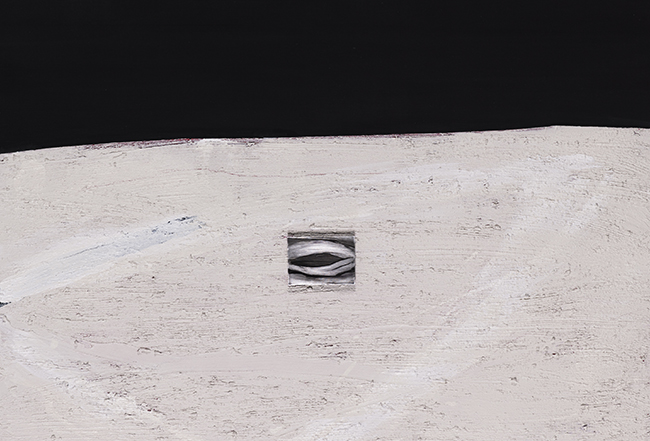
2018心_풍경Mixed media on canvas,lithography90.9-65.1cm (4)
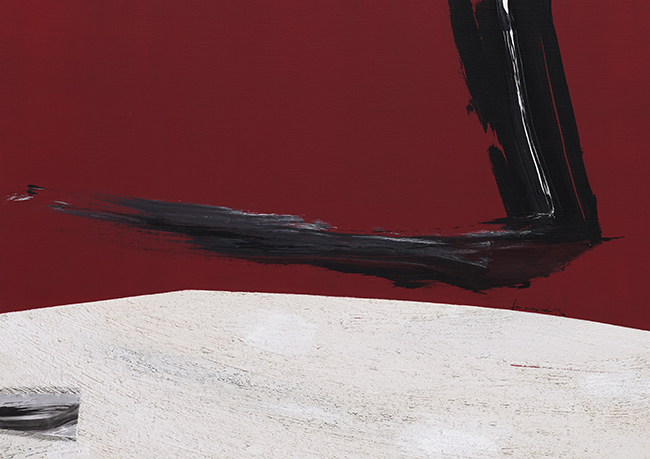
2018心_풍경Mixed media on canvas,lithography90.9-65.1cm
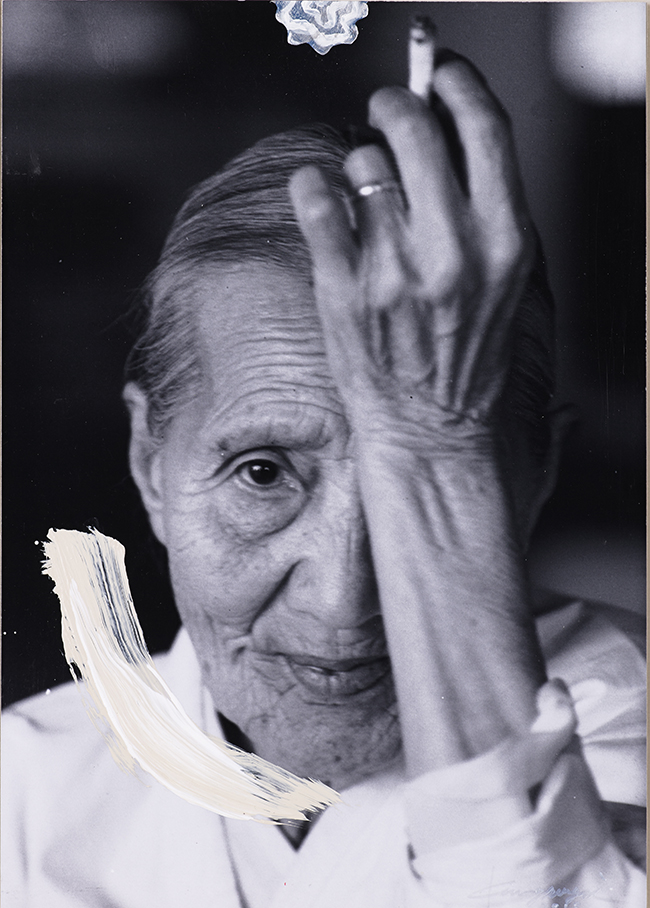
2018心_풍경Mixed media on photography(김수열작)29-41cm (5)
3. 김광미의 작품들은 자신에게 주어진 삶의 무게를 균등하게 산포하는 유일한 도구이면서 존재성과 의미를 담아내는 거푸집이다. 내면과 마주하는 통로이자 거울이고, 자신만의 예술적 정신과 가슴에 끝없이 쌓이는 희로애락을 담은 장렬한 장소이다. 이를 미학적으로 풀어도 동일하다. 가령, 삶과 그 삶에 관한 시선, 정체성에 대한 질문은 작품에 드리운 공간성과 더불어 공소(空所)의 미(美)라는 원리, 시간성을 동반한다. 전체적으론 자아와 존재의식, 실존에 관한 의문, 자연의 일부로서의 삶에 관한 깊은 성찰이 배어 있지만 동시에 각각의 요소마다 고유의 시간성을 함유하고 있다는 점에서 동시적 파편성을 띤다. 이는 공간, 즉 분할된 화면에서 드러나는 실제의 공간과 기호의 공간으로 구분되고, 실제의 공간과 기호의 공간은 모두 김광미 자신으로 귀납되는 공통점이 있다.
귀납을 가장 효과적으로 나타내는 작업은 근래 작업에서 더욱 강해진다. 기본적으로 삶과 일상의 의미복제라는 프레임은 달라지지 않았으나, 시공의 변주와 맞물린 심리성이 보다 간결하게 함축되어 있다. 작품자체는 매우 체계적이나 즉흥적이고 임시적 공간을 통한 공감각적 상황은 무언가에 대한 집요함이 녹아 있다. 이는 표현한다는 행위와 감각의 가능성을 탐구하고, 묘사와 그리기를 넘어 인지와 사고, 개념에 치우치지만 오히려 그것을 통해 새로운 미적 가치를 일깨우기 위한 시도라는 점에서 눈여겨볼 만하다.
누구에게나 인식 가능할 만큼 이해가 원활한 것도 아니고, 취합의 구조 역시 이치를 따지기도 어려우나, 그는 물리적, 심리적 제약 혹은 원초적 내면을 작품에 그대로 수용하여 자연스럽게 삶의 일상성이 미술에 침투하게 둔다. 끊임없이 길을 잃고 헤매면서 길을 찾으려는 (일부 작품에서의 격렬한 선과 붓질에서 알 수 있듯) 뜨거운 몸짓, 불안한 인간의 위치, 생존을 위해 몸부림치는 현대인의 불가피해 보이는 상황을 고스란히 녹여내고 있다. 작가는 이와 같은 조형어법을 통해 삶의 일상성을 깨트리고, 시공을 숙고하며 심리적 해방 재밌게도 심리적 해방은 하나의 공간 속에서 병렬-중첩되면 기존 시청각적 체계는 무너지고 새로운 영역이 만들어지며 구축된다. 여기엔 구분, 제지, 차단이라는 규칙적 용도의 의미까지 포함된다.
을 맛본다.
따라서 우린 그의 그림을 보며 삶과 존재라는 미지의 세계를 고찰하며, 삶과 이상이라는-현실적 이상과 이상적 현실이라는 양립불가능성에 관한 가능성의 이미지를 훑는다. 나아가 특정 카테고리 내부로 스스로 귀속시켜온 관념을 해체함과 더불어 새로운 질서마저 맛보게 된다. 그건 밝은 성품 뒤에 아련한 슬픔이 들어 있고, 다른 방도가 없기에 어떻게든 이어가려는 노력과 현존성을 탐구하는 삶의 모색을 그의 작품을 통해 체감할 수 있기 때문이다.
한편 오늘의 작업을 잇는 수년 전의 작품들 <삶-풍경…애(愛)>연작이나 <삶-바라보고-바라보기> 시리즈 등이 그렇다.
은 현재의 작업에 비해 상당히 투박하다. 인간, 나뭇잎과 같은 자연물, 기호로써의 도형과 오브제의 활용이 보다 구체적으로 적시되어 있어 현실을 터전으로 한 억눌림과 비틀림, 작가로서-인간으로써 살아야 할 동시대 희망과 애환이 진하게 서려 있다.
그에 비해 근작들은 군더더기를 제거한 여운이 크다. 살아가야 한다는 것, 붙잡아야할 삶의 지속이란 실제적 삶에서 어떤 가능성들의 분절과 집합을 의미하고, 그것은 본질적으로 작가적 삶의 고지에 해당된다. 또한 타인과의 관계에 의해 직조되는 실존의 세계와 맞닿고 있다. 그러기 위해 설명은 줄였고 함축적인 의미만 골라냈다. 때문에 현존의 자각을 선험한 채 보다 짙은 체험을 유발하는 매개로써의 그림이라는 인상이 강하다.
특히 작금의 작품들은 흡사 나무가 나이테를 두르듯 명도의 짙음이 가중되고 있으며, 이는 순연의 삶, 운명일 수 있는 현실에 관한 작가적 진솔함을 더욱 빛나게 한다. 그렇게 그는 ‘관조의 망루’에 선 채 매일같이 삶과 실존에 대해 물으며 답하고 있다.
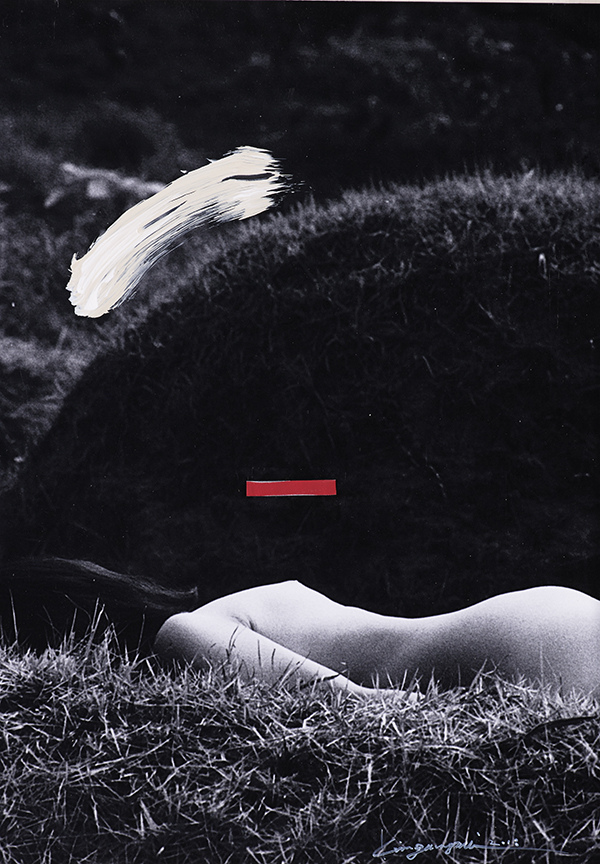
김광미671302018心_풍경Mixed media on photography(김수열작)29-41cm
■ 그룹전/Group Exhibition
2018 제15회 EMG_ group전 (갤러리인사아트, 서울)
내밀한 쾌 (예술표현활동지원선정,인천문화재단-운영위원장/갤러리GO, 인천)
미술관 자작나무숲-3人초대전 (강원도, 횡성)
[각- 시선] 7인전 (인천아트플랫폼 창고갤러리, 인천)
미술로 풀어보는 행복한 힐링1/ 인천여성작가회전(인천종합문화예술회관, 인천)
미술로 풀어보는 행복한 힐링2/ 인천여성작가회전(갤러리GO, 인천)
유곤미술관 개관기념전 (위해/ 중국)
2017시대적 예술의 시선(예술표현활동지원선정,인천문화재단-운영위원장/갤러리GO,인천)
현대불교예술의 조망전(강릉시립미술관, 강릉)
길-돌아보다 (추계예술대학교동문전/ 현대미술공간C21, 서울)
제14회 EMG_ group전 (환갤러리, 서울)
동행仕.思-4인전 (1898갤러리, 서울)
봄길위에서다/ 인천여성서양화회 35회정기전 (인천평생학습관 나무갤러리, 인천)
예술과 일상사이 감성을 입다 (인천아트플랫폼 창고갤러리, 인천)
2016 한국현대미술 3인 여류작가초대전 (갤러리樂, 제주)
제13회 EMG group전 (가나인사아트센터, 서울)
길-돌아보다(추계예술대학교동문전/현대미술공간21c, 서울)
인천여성서양화회 34회정기전 (선광문화재단 갤러리, 인천)
사진과 회화 View (갤러리GO, 인천)
기억, 그 형상을입다 (유리섬 맥아트미술관 초대전, 경기도)
SCAF ART FAIR (롯데호텔, 서울)
부산국제아트페어초대작가 (Busan BEXCO, 부산)
첸나이 챔버비엔날레 초대작가 (인도, 첸나이)
2015 12ARTISTS VERGIL America초대전 (Wee Gallery아리조나, 미국)
‘샌버나니노 바람에 날리다’ 초대전 (샌버나니노 아트밸리, 미국)
가을-빛을 비추다 (추계예술대학교동문전/금보성아트센터, 서울)
황창배를 기억하다 (금보성아트센터, 서울)
인천아트페스티벌전 (갤러리GO, 인천)
인천여성서양화회 33회정기전 (송도경제자유구역청 갤러리, 인천)
제12회 EMG group전 (환갤러리, 서울)
Our History (인천종합문화예술회관, 인천)
부산국제아트페어초대작가 (Busan BEXCO, 부산)
첸나이 챔버비엔날레 초대작가 (인도, 첸나이)
2014 인천아시안게임및 책의수도특별전 (Art Plug, 인천)
현대미술40년 다시, 또다시 (추계예술대학교 기증전/현대미술공간21c ,서울)
ACCOMPANY-포토아티스트 故김수열/김광미(부천시문화예술발전기금/갤러리광장,부천)
아시아국제미술전-녹색성장 재활용미술과 자연미술(인천종합문화예술회관, 인천)
여성, 새벽을깨우다-인천여성비엔날레회원전(인천미추홀도서관기획, 인천)
아! 대한민국전 (갤리미술세계, 서울)
인천여성서양화회 32회정기전 (미추홀도서관 미추홀터갤러리, 인천)
제12회 EMG group전 (환갤러리, 서울)
부산국제아트페어 (Busan BEXCO, 부산)
■ 프로젝트 (지원선정 사업)
2018 개인전 / [心] (예술표현활동지원선정, 인천문화재단/ 갤러리GO,인천)
내밀한 쾌 / 환경미술협회 인천지회 기획전/ 기획운영위원장
(예술표현활동지원선정,인천문화재단/갤러리GO, 인천)
2017 시대적 예술의 시선/ 환경미술협회 인천지회 기획전/ 기획운영위원장
(예술표현활동지원선정,인천문화재단/갤러리GO, 인천)
2015 개인전 / 삶-풍경...愛 (예술표현활동지원선정, 인천문화재단/ 갤러리GO,인천)
2014 ACCOMPANY-포토아티스트 故김수열(아버지)/김광미
(부천시문화예술발전기금/ 갤러리광장, 부천)
■ 작품소장
추계예술대학교
An Essay on Gwangmi Kim’s Recent Work
Existence and Conversation at ‘Pharos of Betrachten’
Kyunghan Hong (Art Critic)
1. The works of the artist, Gwangmi Kim, encounter a question of existence. As existence is about consciousness of being in the world, an artist’s manifestation begins with realizing the gap between ‘spiritual and physical’ matters and self-awareness of existence as a human being living with others. Thus, her paintings, with themes such as life and landscape, contemplation, mind, breath and love, aim for specified and personal matter beyond simple abstract form, and deal with the signification of being and the way one exists. To her, art is a sensitive act of self-reflection about being.
Gwangmi Kim’s work sprouts under circumstances of restricting or being restricted in life, and the art form she seeks to create grows between revealing and concealing. This is a kind of inner rhythm. Revealing and concealing spread their roots in her work based on their complementary relation. The grain of her art appears deep and implicit in the work so that a trajectory of her life, which exposes the gradual and anguished time of dried up stagnation to be finally integrated in the days of eon, is reflected.
This ‘Trajectory of Life’ is placed on two different lines. The first line is about the cause of her art form. The subject upon which the artist has been elaborating for a long time is to contemplate, and such contemplation develops narratives. Then, the narratives become a specific language laid on the trajectory, enough so to be called a ‘landscape of trajectory,’ created at the moment that the language appeared. However, as love and mind imply, these ironically are not in a tangible range because they are semiotic, symbolic and indirect.
Only through the way of seeing her painting, which indicates a system of representation in order to have empathy, and through the captured notion that is inversely proportional to materiality, can we fathom the self-questioning of being which lives in an endless repetition of moments. As shown in the history of Abstract Expressionism paintings, resonance does not only stand for the realm of representational art. In that, Gwamgmi Kim’s work embraces a unique inner rhythm, and is competent enough to sway people’s mind.
The second line of the ‘Trajectory of Life’ is a self-projection that relates directly to her life. Kim’s art implies that her work relates mainly to the psychological reaction that conducts emotions and the will aroused in ‘the shade of mentality.’ There’s no fantasy and no toil named ‘society’ that oppress her. Instead, her work has formative citation that speaks for lack and fulfillment in the real world, and embodies the thirst for freedom and salvation from inner turmoil and the insecurity of being. The vanishing point of all those things is from her self-consciousness, and based on that vanishing point, lay nouns such as freedom from restraints, communication, desire, self-restriction, contemplation and introspection.
Kim’s recent work might be close to being, which can only be imperfect, much like her old works shaped with thick and rough materiality were. This imperfection is also the reason that humble being and the anxiety stirred from the desperate but wearisome waiting after the long yearning for the never-seen but instinctively sensed utopia, wander around.
2. Gwangmi Kim’s painting states that her canvas is a truthful stage where she encounters the world with bare face, and where her reaction from encounter with the world spreads out. To her, the world is comprised of reflections generated from experiences through her body and mind. Her recent work especially is a result of joy and sorrow, frustration and agony, woe and triumph, and etc. filtered through her aesthetic skimmer.
Interestingly every single possible element in Kim’s artwork is never a figurative representation originated from a certain object, and never comparable with anything. As such, her artwork tends to follow a sensible and intuitional flow, and never sticks to imitational representation. However, such a tendency allows viewers to have various poetic sentiments of their own based on different values and perspectives. In that, her art is generous.
For instance, considering visual presentation in her painting, many of her recent works that are divided into black and white, and formed with geometric triangles and quadrangles, do not seem to relate directly to the concept of the ‘landscape of trajectory’ mentioned earlier. They focus more on concepts of reservation and the restraint of adjustment through formative elements such as sides, lines and colors. At this point, the adjustment means activating (or congesting) the act of emptying and filling, but in doing so, what really matters here is that she attains her unique sense of aesthetic from practicing the ‘principle of blankness,’ which in this case, focuses on ‘filling’ rather than ‘emptying’
Kim’s object art that has more distinctive materiality shares the same notion. The object that has eccentric oval images inscribed on a metal plate is charged with its own identity in a dark and dry space. As the object is made of metal, its materiality stands out even stronger, unlike a flat surfaced painting. In this regard, the formative contrast becomes more remarkable, and the artist’s undertone, which is personal and individual, gains more attention. This object embraces the artist’s personal history as a female artist, and the combination of flat and solid forms creates a space of reaction, which is predictable, unpredictable, and even somehow sudden.
Among all those elements, the mountain-like figures, triangles, and human or nature figures that often appear also in her other works, is a metaphoric narrative of the subject. Particularly her split-screen technique emphasized in her recent work embodies ambivalence property in that the split line tends to expand the hidden space, which is implicit in non-visualized images through the line on the screen, and at the same time, closes the open space existing on the screen.
In her work, ambivalence property carries the means of segmentation between the artist as an individual and the community she belongs to. It is the restrained today, the distant contemplation from mutual accordance and sensible observation. The contemplation and the observation embodied in the wide blank dash for the ultimate, yet they summon the relation between inner and external conscious by merging the images and objects that embrace materiality and non-materiality in that they touch time and space. In a broad sense, such concepts become a clue to trace the reciprocity between severance and communication, and the subject and others. From this, we can understand that her work is to self-question in terms of existence realized through homogenization and de-territorialization of her life trajectory, which is the main topic of her work. Such concepts also offer deep empathy to others, who can have a moment to retrace themselves through her painting.
As such, Kim’s work discusses existence and absolute cause. It also becomes a beginning of simply aroused poetic description, which contains visible and invisible things reaped from the journey of life, and playing non-identity with rhythms between the conscious and unconscious. To her, art is a formative form of non-formatives and the process that modifies and forms new value at the level of aesthetic dimension, which begins with speculative level.
3. To Gwangmi Kim, her artwork is the only tool to scatter the weight of her life she carries, and the mole that contains her existence and meaning of life. It is a corridor to face her inner-self, and the place that encompasses her spirit of art and all the different emotions, which will be eternally accumulated. Her work will be explained the same from the aesthetic point of view. For example, questions about identity, life and the eyes for life are accompanied with spatiality, the beauty of the void, and the temporality permeated in her artwork. It carries self-conscious and self-awareness, questions about existence, contemplation toward life as a part of nature on the whole, yet at the same time, Kim’s artwork is charged with simultaneous fragmentation in that each element embraces its own temporality. In her painting, there are two split spaces, one for the actual space revealed on the canvas and another for the symbolic space. In here, the actual space and the symbolic space have one thing in common in that they all inductively return to the artist herself.
In her recent art practices, Kim seems to emphasis such inductive process in her artwork. The basic frame of her artwork, which is a sematic reproduction of life and routine, does not change, but the psychological context engaged with the variation of time and space becomes simpler. The artwork itself is very systematic, but a strong degree of tenacity toward something is melted in with synesthetic circumstance created through spontaneous and occasional space. This is worth paying more attention to in that it becomes an attempt to study expressional behavior and sensible possibility, and to realize new aesthetic value developed from the act of perceiving, thinking and conceptualizing, which is beyond describing and drawing.
It is not easy for everyone to understand, and difficult to give reason to the gathering structure, yet she lets the dailiness of life naturally permeate her art by soundly accepting physical and psychological restriction and inner instinct to her work. Eager gestures to seek the way while ceaselessly getting lost (vigorous brush strokes and lines shown in some of her paintings reveal such gesture), the insecure position of human beings and the desperate gesture of contemporary human beings for survival are all melted down in the notion above. Through such artistic language, the artist contemplates time and space, and experiences psychological freedom.
Therefore, viewers contemplate the unknown world of life and existence by encountering her painting, and glaze over the possible image in terms of the incompatibility between the ‘realistic ideal’ and ‘idealistic reality.’ Furthermore, viewers can witness the destruction of self-restraint in a certain category, and eventually taste a new order.
Meanwhile, her old works that connect a bridge to her today look quite rough compared to her recent works. Human figures, natural figures like leaves, symbolic figures and the use of objects appear more obvious to read distorted and oppressed reality derived from life, and frustration and hope as an artist and an human being in this contemporary society.
By comparison, her recent work lingers large in the mind after taking out all superfluity. To live and to maintain life means segmenting and gathering in reality, which is fundamentally the ultimate goal of the artistic life. Her recent work also meets the world of existence that is weaved by relationship with others. To do so, explanation is reduced and connotative meaning stands out. Due to this, her painting becomes an agent that has gained the experience of awareness of existence, and causes even deeper experience for the others.
Specifically, her art works in most recent days are tinged more vividly as if a tree grows its rings, and this illuminates her artistic honesty in terms of destined reality and veritable life. Like above, Kim stands at the ‘Pharos of Betrachten’ (the tower of contemplation) and self-questions and answers those questions about life and everyday existence.

